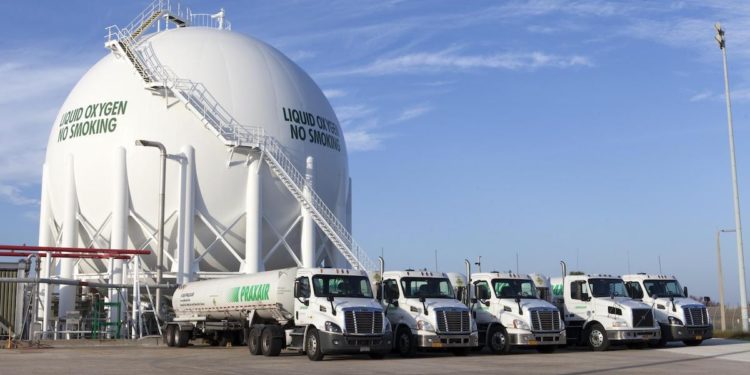
The effects of a nationwide liquid oxygen shortage caused by the recent spike in hospitalized coronavirus patients has already delayed the launch of a Landsat imaging satellite by a week, and threatens to impact more missions from launch sites in Florida and California.
NASA said last week that the launch of the Landsat 9 satellite aboard a United Launch Alliance Atlas 5 rocket from Vandenberg Space Force Base in California would be delayed one week until no earlier than Sept. 23 due to a lack of liquid nitrogen at the military base. ULA uses gaseous nitrogen, which is converted from liquid nitrogen, for purges during testing and countdown operations.
The space agency said pandemic demands for medical liquid oxygen impacted the delivery of liquid nitrogen to Vandenberg.
Del Jenstrom, NASA’s Landsat 9 project manager, said Tuesday the liquid oxygen crunch spilled over to affect liquid nitrogen deliveries as tanker trucks were repurposed to carry oxygen to medical facilities treating COVID-19 patients.
The Defense Logistics Agency, which oversees a facility at Vandenberg that converts liquid nitrogen into gaseous nitrogen, determined last week that the military base’s nitrogen supply was “critically low” and insufficient to support pre-launch testing of the Atlas 5 rocket for the Landsat 9 mission.
Airgas, a supplier of industrial and medical gases, is relocating a “dozen or so” tankers from the Gulf Coast region to California to restock Vandenberg’s nitrogen supply, Jenstrom said.
“Most of those tankers came in over the weekend, so we’re seeing a substantial increase in the number of LN2 (liquid nitrogen) deliveries to the base right now, and as far as we know, based on latest reports, we’re on track to support our launch on Sept. 23,” Jenstrom said. “And that includes an important rocket fueling test and rehearsal called a wet dress rehearsal that should happen this week.”
Once ULA completes the dress rehearsal, teams will hoist the Landsat 9 satellite — a joint program between NASA and the U.S. Geological Survey — on top of the Atlas 5 rocket on the SLC-3E launch pad at Vandenberg.
ULA rival SpaceX is also watching the liquid oxygen shortage.
A few days before NASA announced the Landsat 9 launch delay, a SpaceX executive said she anticipated a lack of liquid oxygen could impact the company’s launch schedule.
“We’re actually going to be impacted this year with the lack of liquid oxygen for launch,” said Gwynne Shotwell, SpaceX’s president and chief operating officer, said Aug. 24. “We certainly are going to make sure hospitals have the liquid oxygen that we need, but for anybody that has liquid oxygen to spare, would you send me an email?”
Some cities have asked residents to reduce water usage to address concerns about liquid oxygen supplies to hospitals.
Elon Musk, SpaceX’s founder and CEO, said the liquid oxygen shortage has, so far, not affected the company’s launch operations.
“This is a risk, but not yet a limiting factor,” Musk tweeted Aug. 26.
SpaceX is the the space industry’s biggest user of liquid oxygen. The company uses liquid oxygen, which is stored several hundred degrees below zero, in combination with kerosene to power Falcon 9 rockets into orbit.
SpaceX’s next-generation Starship launch vehicle, currently undergoing testing in Texas, uses methane fuel mixed with liquid oxygen.
Rockets need an oxidizer to fire their engines in space, where oxygen doesn’t exist to allow engine combustion.

Both stages of ULA’s Atlas 5 rocket use liquid oxygen — the first stage with kerosene fuel and the second stage with liquid hydrogen fuel.
SpaceX launched its most recent Falcon 9 mission Sunday from Kennedy Space Center in Florida, consuming hundreds of thousands of pounds of liquid oxygen.
ULA loaded 800,000 pounds of liquid oxygen into a pathfinder booster for the company’s new Vulcan rocket at Cape Canaveral Monday for a cryogenic loading test. After the ground test, ULA drained the oxidizer from the rocket to be used again.
NASA’s Space Launch System moon rocket will also need large quantities of liquid oxygen when it begins launch pad testing, possibly before the end of this year. The SLS rocket is powered by engines that consume the oxygen in combination with super-cold liquid hydrogen.
NASA says it already has enough liquid oxygen stored at the Kennedy Space Center for a fueling test of the Space Launch System, plus multiple launch attempts.
The shortage of liquid oxygen isn’t the only COVID-related supply issue impacting the space industry.
Shotwell said SpaceX is also feeling the effects of the global chip shortage, which she said has delayed development of new user terminals for the company’s Starlink internet network.
Email the author.
<em>Follow Stephen Clark on Twitter: @StephenClark1.
